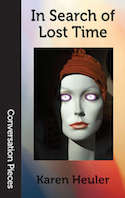Future Alternative Past: Dead(ish)
Every month, Nisi Shawl presents us with news and updates from her perch overlooking the world of science fiction, fantasy, and horror. You can also look through the archives of the column.
Live long and prosper
Last night I dreamed, prosaically, that I was conversing with my oldest niece. My half-sobs kept trembling up to disturb the surface of our conversation; I excused myself to her by saying how much she looked like her mother, my baby sister, dead now four years. Then I woke, realizing that the face and voice I’d been talking with didn’t merely resemble my sister’s, they were my sister’s, back when she was young, vibrant, beautiful, cancer-free. Alive.
So there you have two forms of immortality: survival via remembrance and via genetic legacy. But this has never been enough for the bulk of us. Like religion, SFFH has sought for centuries to address that lack. Beginning with Mary Shelley’s 1818 novel Frankenstein, continuing through George Eliot’s 1859 novella “The Lifted Veil” and beyond, the fantastic genres have consistently questioned the supposed impenetrability of the barrier between life and death. Which you would naturally expect from ghostly tales of haunted mirrors and clairvoyant ascetics and so forth, but sometimes science and technology get dragged into the fray.
“Corpsicles,” as they’re facetiously referred to, are one example of sfnal immortality made (perhaps prematurely) real. The thought is that frozen people — whole bodies, or, less expensively, just their heads — will be thawed and restored to life decades after they’ve died. Though Walt Disney was an early supporter of human cryogenics, he didn’t get himself frozen, (let alone become the first corpsicle, as is often rumored). That honor goes to Dr. James Bedford, whose body, after his death in 1967, was cooled to a temperature of minus 79 centigrade and is now stored at Alcor Life Extension's Arizona facilities.
The answers to moral, technical, and other questions rising from the practice of cryogenic suspension — Would revived corpsicles have legal rights? What would motivate their resuscitation? Who could be held responsible in the case of accidental thawing? — are explored by quite a few SFFH authors. In addition to those listed in the linked articles I recommend Tanith Lee’s novelette “The Thaw.”
Another favorite sfnal way to cheat death is to upload one’s memories and/or consciousness into another living being’s brain or, more typically, into a computer. In Octavia E. Butler’s Wild Seed, her villain Imaro does the first at will; he couldn’t care less that his head-hopping dislodges and kills a body’s original tenant. James Patrick Kelly’s “Think Like a Dinosaur” examines a problem that develops when transferring consciousness to artificially created bodies. William Gibson and most cyberpunk authors opt for the machine upload scenario, and of course ethical quandaries can be involved there as well, as readers of my Making Amends series (“The Mighty Phin” et al.) are aware.
The aforementioned Gibson famously said: “The future is already here — it's just not very evenly distributed.” Which may well be the truth when it comes to a third form of sfnal immortality: medical advances. Already we have a sharp disparity in average life expectancies due to the availability of insurance and the quality of care afforded the rich as opposed to the poor. Already we have toilets that monitor urine flow and analyze hormone secretion. Bruce Sterling’s 1996 novel Holy Fire) extrapolates these points out to a time when his protagonist shops for an affordable, reliable life extension treatment. Never mind the excruciating pain she must subject herself to — this is a largely financial decision. Also one on which market forces, planned and unplanned obsolescence, and general demographics come to bear.
Recent books recently read

Despite In Search of Lost Time’s (Aqueduct) omnipresent cancer treatment medtech, this standalone novella resonates less with the hard science stylings of cryogenics, uploads, and gene-tailoring than it does with the happily-ever-after limbo at the end of fairytales. Author Karen Heuler’s heroine Hildy discovers that chemo infusions targeting malignant lesions on her “tempora” — an imaginary area of the brain — allow her to see, manipulate, and ultimately steal other people’s time. Her superpowers neither free nor cure Hildy, though. Instead, she struggles to integrate them into a humane and principled philosophy while fending off the self-interested alliances of warring would-be time-mongers. She girds herself for battle in red-heeled boots, silk head scarves, and penciled-on eyebrows, but kindness and self-reflection prove to be her most kickass weapons.

Firebrand (Tor Teen) is A.J. Hartley’s second novel set in Bar-Selehm, a gritty, steampunk analogue of South Africa. Steeplejack introduced readers to Anglet Sutonga, who began the book as an impoverished young laborer among Bar-Selehm’s chimneyed rooftops and ended it hired by her government’s main opposition party as a spy. Now Sutonga, member of a racial minority distinct from the region’s ruling whites and indigenous blacks, becomes entangled in a plot involving smuggled war refugees and stolen blueprints for a deadly machine gun. With her usual flair for leaping headfirst into trouble and sorting out the consequences later, she takes on a psychopathic assassin, a supernatural legend come to haunting life, and a hate-spewing white supremacist in her pursuit of truth and at least an approximation of justice. The results satisfied both my cautious mind and my crusading heart.

Seattle-area Futurist Brenda Cooper’s Wilders (Pyr) is the first volume in her new Project Earth series. The premise is promising: megacities house most of North America’s population, with the surrounding land slated for “re-wilding,” a sort of remediation-cum-restoration project. Our entry point into this near-future scenario, though, is the somewhat feckless Coryn Williams, whose older sister Lou strikes out on her own as soon as she can to do cool stuff like reintroduce wolves to the prairie. Coryn, abandoned, must stay a couple of years after that in the milieu that mysteriously led their parents to kill themselves — there’s a paragraph on possible reasons for their suicide on page 196, but by then Coryn has achieved adulthood and set off with her robot companion to track Lou down. Revolt among non-city dwellers and deception among city rulers make for a gloriously unpredictable denouement and hold out hope for more action in the rest of the series.
Couple of upcoming cons
Westercon is your prototypical large regional science fiction convention. Past iterations — all taking place, per the organization’s website, “west of the 104th meridian” — have featured art shows, filking (fannish folk music), and everything else con-goers have come to expect from full-service conventions. This is its 70th year of meeting those expectations.
But wait — do you like SFFH books more than the genre’s movies, cosplay, games, and such? Then Readercon is your cup of vodka. Two tracks of panels talking about books and one room of dealers selling them. That’s it for programming. Authors are the only Guests of Honor — two living and one dead per year — plus a plethora of guests of no particular honor but plenty of literary distinction, like Samuel R. Delany, Kit Reed, and Jonathan Lethem.